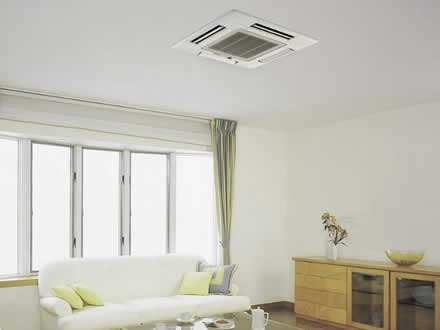
Central Air Conditioning
One of the most popular forms of all-year climate control for many homes is the central air conditioning and heating system (or HVAC) to maintain a comfortable temperature indoors.
How much do you know about your central air system, assuming your home has this feature?
 How much would you like to know about how the heating, ventilation and air conditioning (HVAC) system works and how you can maintain it at a handyman level to keep it running in the most efficient manner?
How much would you like to know about how the heating, ventilation and air conditioning (HVAC) system works and how you can maintain it at a handyman level to keep it running in the most efficient manner?
Most people tend to put their heating and cooling system to the backs of their minds when they're working as they are supposed to, without giving the mechanics behind the equipment any thought at all. That is until it starts to go wrong!
What is a Central Air Conditioning System?
The main job of a central air conditioner is to circulate cool air throughout the house through a system of supply and return ducts or pipes. Here is a short description of how that happens:
Supply ducts and registers, which are the openings in the walls, the floors or the ceilings (these are covered by grills) do the job of carrying cooled air from the main air conditioner unit to all the rooms and living spaces in the home.
The cooled air naturally gets warmer as it circulates its way through the home. So it flows back to the air conditioner to be cooled again through return ducts and registers.
That's the really simple explanation, but there's some more to the process that is interesting enough to know about.
Dehumidification
Air conditioners also dehumidify the air coming into the system, resulting in much less humidity in the cool air coming our as went in. This makes the air feel even cooler.
However, in extremely humid climates or if the air conditioner is under-powered, it may not achieve a sufficiently low humidity level to be completely comfortable.
To combat this situation, running a dehumidifier in an air conditioned home helps to further reduce humidity, although it will increase the amount of energy used since you'd be running the dehumidifier and the air conditioner will use more energy to cool the house.
Another alternative is to retro-fit a dehumidifying heat pipe to the existing system. This will use less energy while achieving a more comfortable humidity level.
Central Air Conditioner Types
There are two main types of house-wide air conditioner. These are:
- The central packaged unit
- The split-system
Packaged Air Conditioner Unit
In a this system, the major components of the system (these are the evaporator, condenser, and compressor) are all housed in a single cabinet. This is located centrally either on a roof, in a cellar or on a concrete slab installed next to the foundation of the house.
This type of air conditioning system is also commonly found in small commercial buildings and office blocks.
Air supply and return ducts are installed through the exterior wall or roof of the building to connect with the central packaged air conditioner. This is usually located outside the building or in a cellar with additional venting to the outside.
Packaged air conditioning units are often combined with electric heating coils or a natural gas furnace. The advantage of this kind of system is that it eliminates the necessity for a separate furnace to be installed indoors.
Split AC System
In a split-system installation, a metal cabinet located outdoors contains the condenser and compressor units. A cabinet located indoors contains the evaporator.
In many split-systems, the cabinet indoors also contains the indoor section of a heat pump or a gas or oil fueled furnace. If there is already a furnace installed in your home but no air conditioner, the most economical solution is to install a split-system central air conditioner.
Why Choose Central Air?
One of the main reasons to choose a central air conditioner over individual room air conditioners is they are more efficient and generally more cost effective on running costs over time.
Another advantage is they are out of the way, not taking up any space that may be better used for other things. They are also quiet and convenient to operate.
To save energy and therefore money, it is best to buy an energy-efficient air conditioner that will reduce your home's energy use.
In an average sized air-conditioned home, the cooling system can consume more than 2,000 kilowatt-hours of electricity per year. The knock-on effect of this is that power plants will emit around 3,500 lbs of carbon dioxide plus 31 pounds of sulfur dioxide per household.
If you are thinking about installing central air conditioning in your home, the need for ductwork may be a deciding factor. Replacing an older central system with a more modern energy efficient model could save you money in the long run by using less energy than the older system.
Resource: www.energy.gov
(Top of Page)
- Copyright © s3.amazonaws.com/air.conditioner All rights reserved
- Privacy